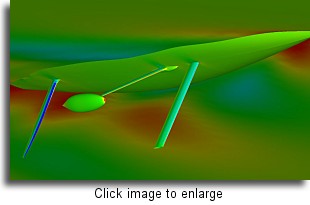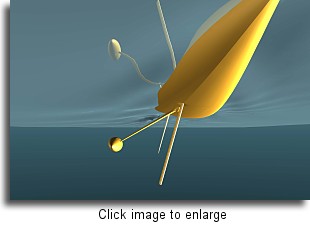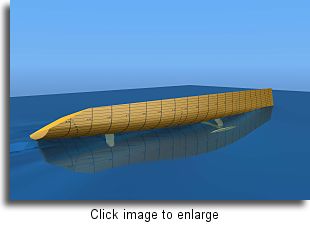|
Magnitude
80
|
|
|
|
Computational Fluid Dynamics
Notes on "Magnitude 80" by EganTech's David Egan
|
|
|
|
 Design
of the appendage configuration for Magnitude was in many instances designing
in unknown territory and the Computational Fluid Dynamic tools enabled
testing the boat in the computer prior to building. The canting keel offers
high stability with a much smaller fin and bulb, where as the forward dagger
board can create a lot of lift when needed and conveniently retracted,
saving wetted surface drag when not going to weather. The design
implications of the configuration are quite overwhelming at first. Concerns
of balance issues while sailing especially with transition from the canting
keel to the Center Board. Or more simply where should the appendages go and
how big should they be? Although the smaller bulb and the canting keel are
an obvious improvement, these boats go very fast even in light air so what
are the effects do the bulb and fin so close to the surface have on wave
drag? At the project start there were many questions so a fast CFD
(Computational Fluid Dynamics ) analysis scheme was implemented to quickly
work through all the various options of canards, rudders, bilge boards and
the design trade–offs. Helm balance was a major concern and many full
configurations were analyzed with the results then incorporated in VPP
analysis to determine the net benefits of the various options. Very quickly
the Dagger Board option became the favorite for drag especially with the
ability to retract it down wind! Looking at the underwater image of
Magnitude 80 we see, with the color coding by pressure (the hot colors are
high pressure and the cold colors are low pressure), that the rudder, fin
and centerboard are all working to reduce leeway. Design
of the appendage configuration for Magnitude was in many instances designing
in unknown territory and the Computational Fluid Dynamic tools enabled
testing the boat in the computer prior to building. The canting keel offers
high stability with a much smaller fin and bulb, where as the forward dagger
board can create a lot of lift when needed and conveniently retracted,
saving wetted surface drag when not going to weather. The design
implications of the configuration are quite overwhelming at first. Concerns
of balance issues while sailing especially with transition from the canting
keel to the Center Board. Or more simply where should the appendages go and
how big should they be? Although the smaller bulb and the canting keel are
an obvious improvement, these boats go very fast even in light air so what
are the effects do the bulb and fin so close to the surface have on wave
drag? At the project start there were many questions so a fast CFD
(Computational Fluid Dynamics ) analysis scheme was implemented to quickly
work through all the various options of canards, rudders, bilge boards and
the design trade–offs. Helm balance was a major concern and many full
configurations were analyzed with the results then incorporated in VPP
analysis to determine the net benefits of the various options. Very quickly
the Dagger Board option became the favorite for drag especially with the
ability to retract it down wind! Looking at the underwater image of
Magnitude 80 we see, with the color coding by pressure (the hot colors are
high pressure and the cold colors are low pressure), that the rudder, fin
and centerboard are all working to reduce leeway.
|
|
|
|
 If
we exaggerate the scale a bit we see interestingly enough that the three
appendages are all working in different flow regimes, which led to the
development of three different foil sections, each designed for minimum drag
at their design operating condition. Help here came from Ian Howlett in the
UK in sorting through the masses of possible foil selections available
today. With these foils sections chosen, the CFD and VPP were again used to
match the correct plan form areas of the rudder, fin and centerboard. The
correct amount of lift is maintained on each fin so that all acting together
give the right balance on the helm. Care was taken here to keep the “design”as
forgiving as possible. If
we exaggerate the scale a bit we see interestingly enough that the three
appendages are all working in different flow regimes, which led to the
development of three different foil sections, each designed for minimum drag
at their design operating condition. Help here came from Ian Howlett in the
UK in sorting through the masses of possible foil selections available
today. With these foils sections chosen, the CFD and VPP were again used to
match the correct plan form areas of the rudder, fin and centerboard. The
correct amount of lift is maintained on each fin so that all acting together
give the right balance on the helm. Care was taken here to keep the “design”as
forgiving as possible.
|
|
|
|
 When fully canted and heeled,
both the bulb and fin find themselves very close to the water surface so a
volume distribution for the bulb was chosen to minimize the drag of this
effect along with fairing and strake for the fin and canting keel mechanism.
The wave effect of the bulb and keel was accurately modeled and is clearly
seen in the wave trough over the fin and bulb. When fully canted and heeled,
both the bulb and fin find themselves very close to the water surface so a
volume distribution for the bulb was chosen to minimize the drag of this
effect along with fairing and strake for the fin and canting keel mechanism.
The wave effect of the bulb and keel was accurately modeled and is clearly
seen in the wave trough over the fin and bulb.
|
|
Back
to 80 foot design page
|